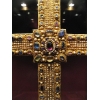|
 When passing by the windows of the jewelry shop, we stop to
stare at those silver items with the ornament, whether intentionally or not.
The frozen ornaments are encircled with the black paint in thinnest line
against the silver glass. The lock of niello is fancifully twisted to admire. The Niello technique, nowadays
almost forgotten, is one of the oldest ornamenting techniques in the world. The
jewelry from niello perfectly shade a gentle woman skin and those made for men
emphasize the status and individual style of wearer. The silver is
created with the tint of aristocratism, lavishly and worthy to come to
collections of family jewels. Niello
is a black metallic alloy of copper, silver, sulfur, and lead, used as an inlay
on engraved metal. It can be used for filling in designs cut from metal. When passing by the windows of the jewelry shop, we stop to
stare at those silver items with the ornament, whether intentionally or not.
The frozen ornaments are encircled with the black paint in thinnest line
against the silver glass. The lock of niello is fancifully twisted to admire. The Niello technique, nowadays
almost forgotten, is one of the oldest ornamenting techniques in the world. The
jewelry from niello perfectly shade a gentle woman skin and those made for men
emphasize the status and individual style of wearer. The silver is
created with the tint of aristocratism, lavishly and worthy to come to
collections of family jewels. Niello
is a black metallic alloy of copper, silver, sulfur, and lead, used as an inlay
on engraved metal. It can be used for filling in designs cut from metal.
Some historical
facts of niello
The word
niello comes from the Latin nigellum meaning «black». The technique of
blackening was widely practiced by many craftsmen who lived in the V century
B.C. when decorating silver items. This is proved by plenty of
archeological findings as niello. However, this kind of engraving was popular
in Russia in X century. During the 10th to 13th century A.D. the Russian craftsmen
mastered the skill in jewelry. They used hot working of iron, wax and stone
molds, inlay with niello and cloisonné enamel and their works had no equal in
the world market.
Niello was
used on a variety of object including and most prolifically, jewelry for women
like necklaces, bracelets, rings, torques, pendants, buttons, belt buckles,
headdresses, and many others.
The masters of other cities shared the technique of
nielloing achieving perfection in this sphere. The Renaissance epoch enabled
distribution of this decoration beyond Russia. Special attention was drawn to
silver snuffboxes, trays, glasses, sword hilts, chalices, plates, horns,
adornment for horses, boxes and trunks for keepsakes. The traditional technique of nielloing is still
alive thanks to the craftsman M.Koshkin and his apprentice M. Chirkov. The
peculiarity of that technique was the unique technology of preparation and
alloying of metals and precious metals to bring additional strength and rich
color to the jewelry. Craftsmen mainly used plant motifs as well as images of
mythological animals and birds to engrae over the ready stuff.
Fame throughout the world
The jewelry from niello are of high popularity today. The
nielloed items are acquired for exposition in museums, they are put to auctions
at famous bidding houses. Thus, a nielloed tureen from 1795 was put to auction
at Sotheby’s as the «silver hidden by immigrants» branded by the craftsman
Semen Kuzov. The preliminary estimate was thirty thousand USD, though the new
owner acquired it for 338,5 thousand dollars.
When
choosing the silver table set for family collections, consider the Russian
companies as «Kubachi» and «Severnaya chern». Though the European
Jewelry houses do not yield and as for the price range, they outrun the Russian
craftsmen for a range. So, the French silver by the brand «Christofle» for
twelve persons costs approximately 18-24 thousand dollars. If you compare, the similar set of 157 items
for twelve persons by the brand «Severnaya chern» is less than 18 thousand
dollars.
The fashion
for nielloed items is again in. the jewelry perfectly matches with the everyday
wear and are ideal as complement to evening ensembles. Previously silver
jewelry was the privilege of the youth due to the price. Though, today many celebrities
and wealthy people show their concern in nielloed items. The silver accessories
with niello are extremely trendy though rare people can afford the silver
necklace or a bracelet.
Nielloed silver
is trendy till now and the nobility of the metal and skill of craftsmen will
involve everyone in the admiration with the items. And everyone will fin its niello to purchaseand enjoy.
|